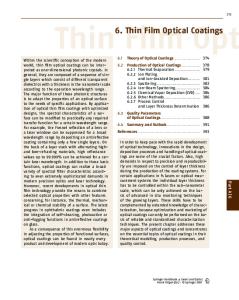Hydrogenated Silicon Carbonitride Thin Film Nanostructuring Using SF 6 Plasma: Structural and Optical Analysis
- PDF / 2,671,538 Bytes
- 10 Pages / 595.276 x 790.866 pts Page_size
- 110 Downloads / 275 Views
ORIGINAL PAPER
Hydrogenated Silicon Carbonitride Thin Film Nanostructuring Using SF6 Plasma: Structural and Optical Analysis S. Saloum 1 & S. A. Shaker 1 & M. N. Alkafri 1 & A. Obaid 1 & R. Hussin 1 Received: 10 October 2019 / Accepted: 10 January 2020 # Springer Nature B.V. 2020
Abstract Hydrogenated silicon carbonitride thin films have been deposited on silicon substrates in a plasma enhanced chemical vapor deposition (PECVD) system using hexamethyldisilazane (HMDSN: C6H19Si2N) as an organosilicon monomer precursor, the plasma polymerized HMDSN (pp-HMDSN) films surfaces have been subsequently nanostructured via SF6 plasma surface etching for different etching times of 0.5 min, 1 min and 3 min. The plasma etching of pp-HMDSN thin film surface affected its surface morphology, chemical structure, wettability property, optical anti-reflectance characteristics and photoluminescence (PL) emission property. It is found that with etching time increase, the refractive index decreases and the PL energy bandgap increases as the silicon content and chemical bond Si-C intensity in thin film decrease, the optical reflectance spectrum changed in shape and position of minimum reflectance and the surface is converted from hydrophilic to hydrophobic one as surface porosity is enhanced. Keywords FM . FTIR . Hexamethyldisilazane . Hydrogenated silicon carbonitride . Optical properties . SEM . Plasma etching
1 Introduction Silicon carbonitride, having no analogs in nature, is an emerging material in silicon-based technology due to its combination of the best properties of silicon carbide, silicon nitride and carbon nitride. Due to its robust mechanical properties [1, 2], it is a material of interest in different applications such as gas separation membranes [1], luminescent material in silicon (Si)-based light sources [3–6], hard coating [5, 7–12], gas sensing [13–15] and diamond-like carbon coatings [16, 17]. There are different chemical environments and techniques to produce this silicon carbonitride material including reactive Radio-Frequency (RF) sputtering a silicon carbide target in N2/Ar/H2 atmosphere [3, 10], or sputtering a silicon nitride target in CH4/Ar/N2 mixture [10], electron cyclotron resonance (ECR) plasma enhanced chemical vapor deposition (PECVD) using SiH4/N2/CH4 gas precursors [4], reactive high power impulse magnetron sputtering of silicon target in
* S. Saloum [email protected] 1
Physics Department, Atomic Energy Commission, P.O. Box 6091, Damascus, Syria
Ar/N2/C2H2 mixtures [7, 18], thermal chemical vapor deposition (CVD) using SiC and Si3N4 powder and H2/N2 carrier gases [9], Laser-induced chemical vapor deposition using liquid hexamethyldisilazane (HMDSN) precursor [19, 20], and PECVD using liquid organosilicon precursors such as bis(dimethylamino) methylsilane [21], tetramethyldisilazane [8, 21] and HMDSN [2, 5, 6, 8, 11, 22–25]. SF6 plasma, providing the reactive etchant fluorine atoms [26], was previously and successfully used for the enhancement of polymers hydrophobicity [27–29], while for
Data Loading...


